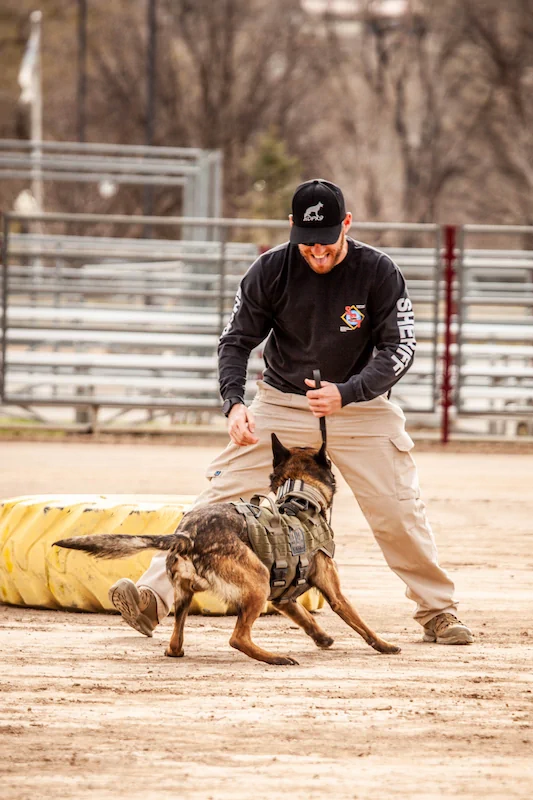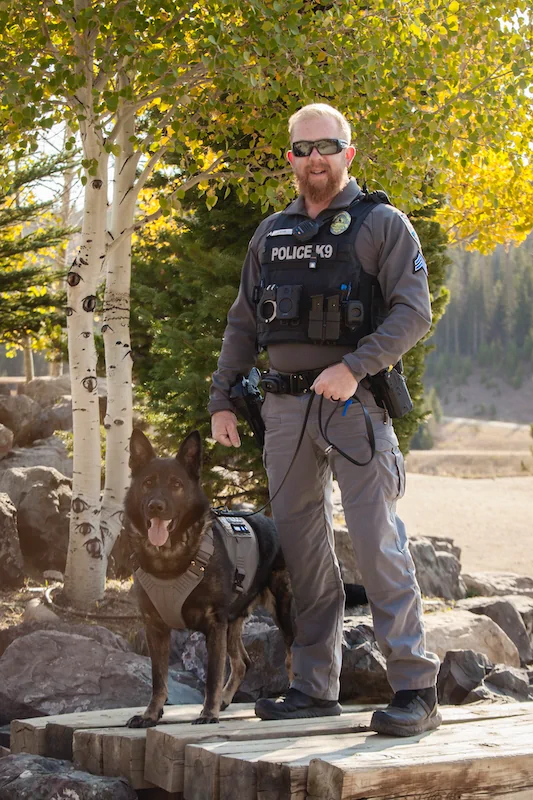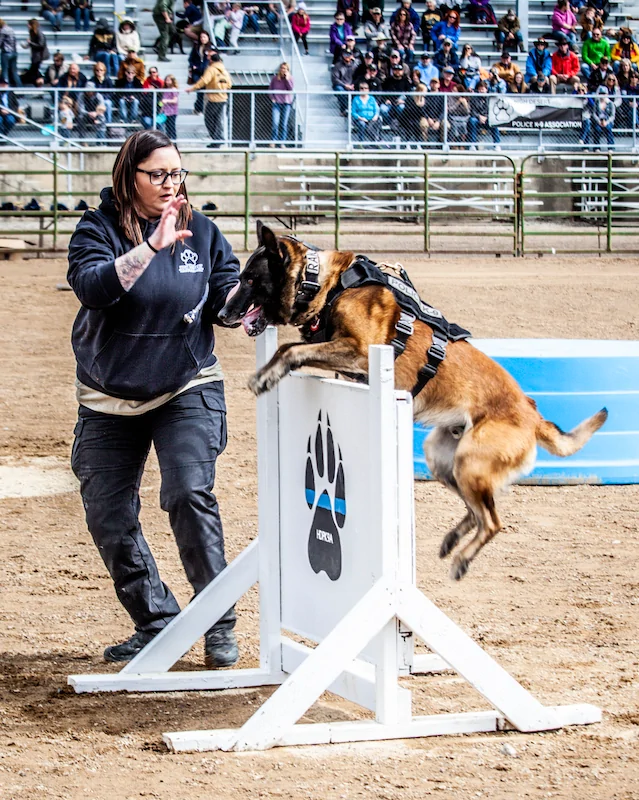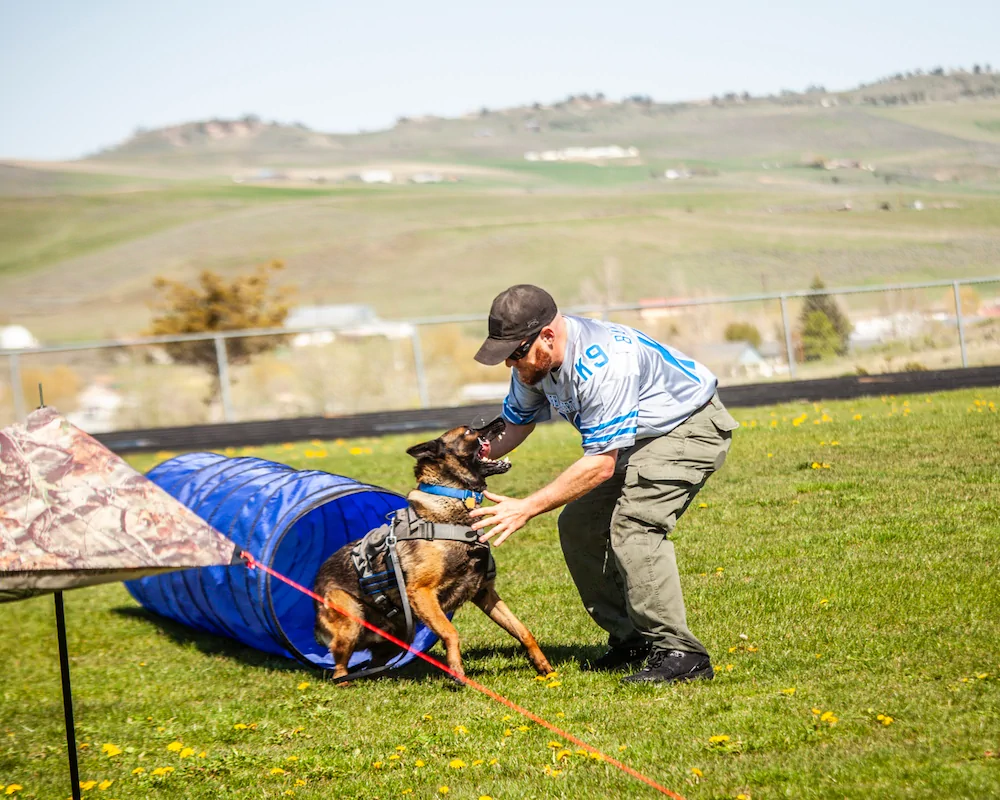K-9 officers take the challenge
Odin, named for the Norse god of frenzy, and Bane, which means glorious defender, were the energetic hometown favorite K-9 officers at the High Desert Police K-9 Challenge competition last May in Craig.
The 6-year-old Belgian Malinois and 5-year-old German shepherd showed off their skills and extensive training for the audience by competing in obedience, agility, speed, and muzzle fighting, plus events to determine who has the strongest grip. The hometown heroes serve with their human handlers and law enforcement partners at the Craig Police Department in tasks such as patrol work, handler protection, illegal-drug detection, tracking, and apprehension.

The annual spring exhibit of canine skills serves as a public education opportunity, friendly competition, and fundraiser for the nonprofit High Desert Police K-9 Association. Established in 2020, the association offers training and certification for canine teams in law enforcement, search and rescue, hospital security, and cadaver detection for smaller agencies and organizations in Colorado, Wyoming, and Utah.
The association currently has 50 canine teams, largely in police and sheriff’s departments. The outdoor competition at the high school football field had audience members in the stands cheering for the abilities of some 20 teams in three different dog age groups.
“You can see the tails on these dogs,” says event announcer Ginny Chase, a retired police officer from Grand Junction. “They are happy to be out here, happy to be working and making their handler proud.”
A merchandise tent sported the furry faces of the working dogs on magnets and coffee mugs. Souvenirs for Odin and Bane sold out quickly.
Audience members ranged from curious dog lovers to family supporters wearing canine team jerseys. The announcer described the skills performed by such dogs as Diesel, Moose, Reese, Te Ka, Bones, Cholo, Jocko, Moki, Teg, Max, and Murray.
Most of the competition was disciplined and sometimes fierce when dogs were commanded to take down a target wearing a padded bite suit. Then handlers called off their dogs and rewarded their four-legged partners with playtime with a favorite toy, often a canvas tug.
If anyone might consider trying to outrun a patrol dog, they should note the fastest canine clocked during the 2024 challenge was just over 3 seconds for a 40-yard dash.
A few times during the challenge, the younger dogs could not resist participating in some cute and funny antics. One younger dog got a little too excited about a stuffed flamingo floating in the kiddie pool that was meant to remain part of the obstacle course and took the pink toy on a short side trip.
Corporal Grant Laehr with Craig Police and president of High Desert says the public image of police dogs has expanded through the years, and community members have become much more comfortable around the law enforcement dogs.
“There was a little bit of a persona that they are just angry dogs and just wanted to bite people, and I believe that perception has changed over the years,” Laehr says. “These dogs are highly trained, and the primary application nowadays is for detection.”
Breeds commonly employed as K-9 officers include German shepherds, Belgian Malinois, black Labrador retrievers, and sometimes a German shepherd/Malinois mix or a German shorthaired pointer. Those breeds of dogs are high energy, determined, and intelligent.
Dog duties, depending on how each dog is trained and certified, may include tracking people such as lost children and older folks with dementia, finding evidence, and apprehending suspects. Some are trained to sniff out illegal drugs including heroin, cocaine, fentanyl, and methamphetamine.
The spring challenge helps the association raise funds through sponsorships and sales of raffle tickets and T-shirts. These funds support the medical needs of retired K-9 officers, send handlers from smaller departments to training, and host regional trainings for handlers to learn new techniques and sharpen skills with their canines.
The day before the public challenge in Craig, the canine teams competed in more-sensitive tasks with no crowds watching. These tasks include detecting both indoor and outdoor explosives, narcotics, and simulated human remains.
During the second day of competition, the loyal K-9 officers were excited to go to work with some straining at their collars or barking while awaiting commands. In the agility course, the dogs were impressive, tackling everything from jumping through hanging tires to walking a teeter-totter.
At home off duty with their handlers, the dogs can be as playful as family dogs. Laehr says his 85-pound partner Bane gets along great with the family’s goldendoodle and cockapoo.

“You’ve got a partner who is your best friend that you know would do anything for you. Being able to deploy them and take substances that are killing people off the street is incredibly rewarding.”
—Corporal Grant Laehr, Craig Police Department
At home, Bane is out of his work uniform of a special harness and leash, so he knows he is off duty. The German shepherd knows the routine of getting into the police vehicle and wearing his work harness indicating he is on duty. Most handlers use commands spoken in German or Czech to deploy dogs on duty.
High Desert association Vice President Kali Henderson, an officer with the Delta Police Department, says her Belgian Malinois partner of four years, Raico, knows he is on duty by his special collar. Laehr says working canines recognize those rituals. “[Bane] is an entirely different dog in the backyard than he is as the patrol dog. He knows when we are going to walk up to a vehicle to do a sniff; he gets happy and excited to go to work.”
Bane likes to play tug and is very toy driven, so after the dog indicates a detection by sitting and pointing, he is rewarded with ball playing time. During five years of work, Bane has been used in 159 deployments.
Some of the law enforcement dogs come from specialized training programs in the United States or Europe, but other dogs are retrained after being initially raised in a civilian environment.
“What we are looking for is the right type of dog with the drive to work and wanting to please,” Laehr says. “You need to have the right dog for the right handler. That relationship is so important.”
Handlers say the work to keep their canine partners in reliable, top shape requires many hours of rigorous and ongoing training — usually 16 hours per month.
“The work that goes into handling a police canine is pretty intensive,” Laehr says. “We train more with canines than probably any other discipline.”
Each year High Desert presents awards in five categories for achievements in tracking, patrol and apprehension, narcotics detection, evidence detection, and cadaver detection. In 2023, Laehr and K-9 Bane were recognized with the Narcotics Case of the Year Award.
Bane’s skills in alerting to drug odors for cocaine and methamphetamine in a hotel room helped put three drug dealers in prison. The dealers also had hundreds of illegal fentanyl pills. A dog trained in narcotics detection alerting to illegal drugs can give police officers probable cause needed to proceed to arrests, Laehr says.
“Over his career, the amount of drug seizures we’ve had is pretty remarkable, especially for the size of the town and local community,” Laehr says. “The bottom line, it probably saved lives by preventing overdoses.”
Last year, K-9 Raico in Delta alerted to a vehicle where a drug dealer was transporting 5,000 illegal fentanyl pills and a large amount of methamphetamine, Henderson reports. That dealer is now serving prison time.
Henderson says that Raico is also a valuable asset in community relations, as he is often used in demonstrations and social visits at schools, libraries, and nursing homes.
Although time consuming, handlers say the work with their canine partners is fun and rewarding.
“You’ve got a partner who is your best friend that you know would do anything for you,” Laehr says. “Being able to deploy them and take substances that are killing people off the street is incredibly rewarding.”
Laehr and Henderson say K-9s used in smaller police departments are on the rise because they are used for detection to help stop the flow of illegal drugs along state highways.
The nonprofit, all-volunteer Colorado Police Canine Association, based in Arvada and founded in 2003, also works to establish professional standards for canine handlers and provide certifications for police service dogs in Colorado. Canine partners can be used to help with security at airports, transit stations, high schools, music festivals, conventions, and sporting events.
Colorado Police Canine Association, with information at Facebook.com/cpcak9, includes 127 canine teams from 43 different agencies, says Krista Schmit, association secretary. This year’s membership represents an increase from the previous year that had 113 teams from 39 agencies.
In Colorado, other specially trained dogs work in fire investigations. The Colorado Division of Fire Prevention and Control uses dogs to track and detect ignitable liquids and decomposing human remains. Currently the division’s officers include two yellow Labs named ROTC and Ash trained to identify accelerants, German shepherd Moose trained as a cadaver dog, and bloodhound Hiccup trained for tracking and trailing.
Fire investigator Brian Eberle says the dogs also are available for public education visits and to help fire departments around the state with investigations.
The teams from High Desert Police K-9 Association will be competing again and serving as energetic law enforcement ambassadors at this year’s challenge scheduled to start at 10 a.m. Saturday, April 26, at Delta High School. Admission is free, but other dogs are not allowed. More information can be found online at Highdesertpolicek9association.org or Facebook.com/HighDesertPoliceK9.

High Desert collects donations to help pay for medical care for member’s retired police dogs. When the K-9 officers retire, their expenses become the responsibility of the handler instead of the department. Henderson notes police dogs usually work to age 8; four High Desert dogs retired in 2024 with three scheduled to retire this year. The big dogs work hard throughout their careers, so injuries or illnesses could last through retirement.
ASK FIRST
People should always ask a handler first before trying to approach a K-9 officer. The canines are protective of their handlers and their patrol vehicles, so approaching without prior permission is not advised.
The Author, Suzie Romig is a degreed, award-winning journalist who lives near Steamboat Springs and has lived, worked, and explored in Colorado since 1990. Photos by Sue Broderdorp.









